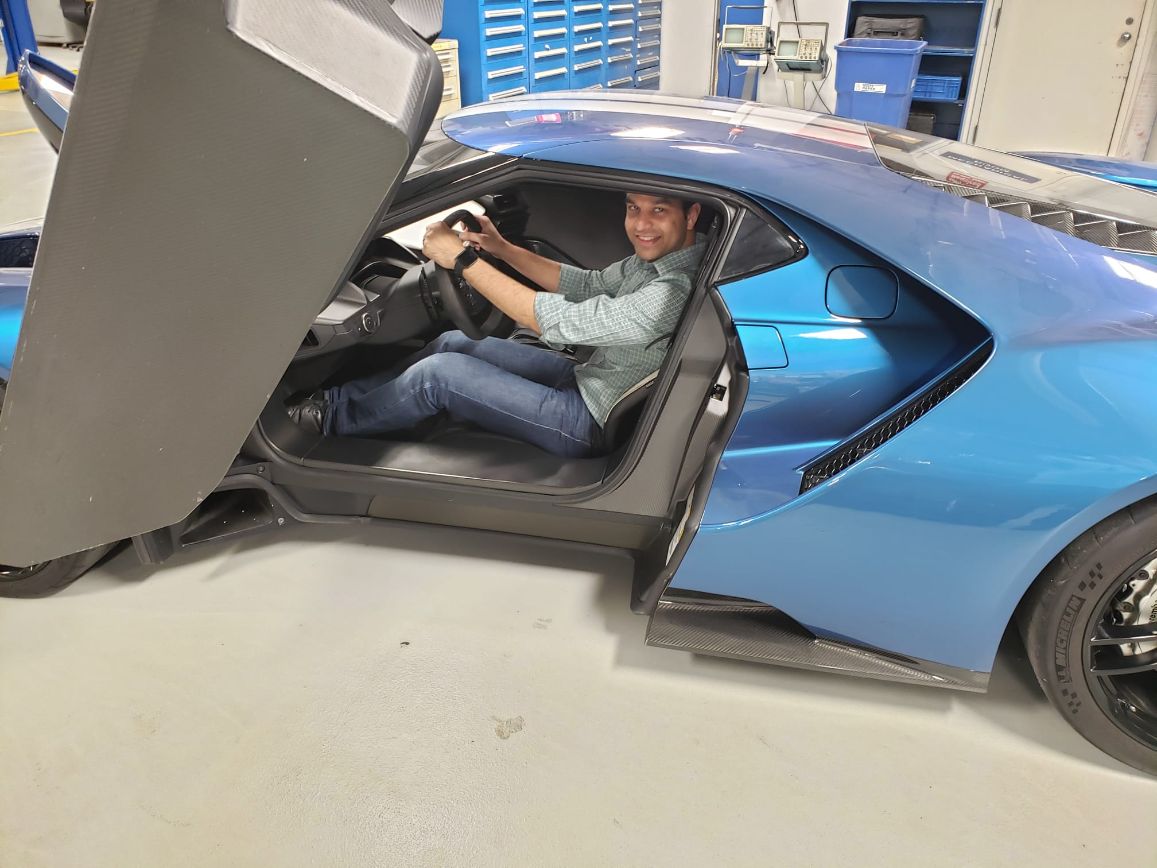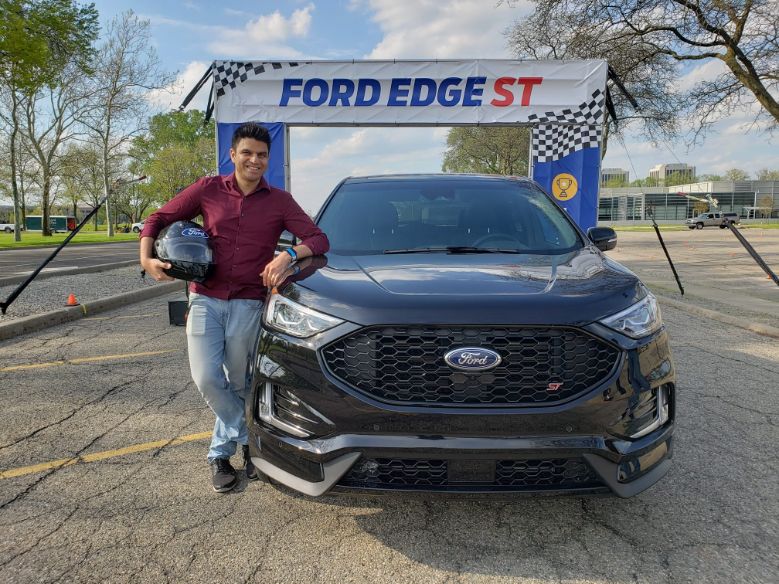Last Updated on March 4, 2024
As a Research Scientist at Ford Motor Company, Ajeya Gupta has been contributing to next-gen vehicle design and features, especially in the areas of in-vehicle networks and self-driving vehicles.
From the start of his career, Gupta has been making great strides in the automotive industry, and in turn, has received recognition for his accomplishments.
Throughout this article, Gupta will be breaking down some of the biggest moments in his career, but we’d like to give a brief overview of those accomplishments before we get started.
At Ford, Gupta has received multiple Research and Advanced Engineering Excellence awards, which are only given to top-tier employees. The fact that Gupta earned two of these awards in just a few years is even more impressive.
Gupta also has a patent for a new restraint monitoring system that intelligently adjusts and deploys safety features as needed during a collision.

Outside of Ford, Gupta has been aiding in the creation of automotive industry standards as part of multiple standards organizations that require cooperation between employees of various manufacturers and suppliers.
Very few professionals in the automotive industry have accomplished so much and tackled such a wide variety of projects and issues. Gupta’s track record is inspiring, to say the least, and it was a real pleasure to talk to him about the standout moments of his career.
Keeping perspective
One last thing before we get to Gupta’s career breakdown: we asked him to share some of his thoughts and feelings on the process of looking back at these accomplishments.
Might there be a risk of reflection leading to self-consciousness or even ego? As it turns out, Gupta rarely looked back on his career achievements in the early years of his professional life.
If anything, he actually preferred to keep moving forward, keeping his sights set on the next goal, the next milestone for himself or for the company.
In fact, Gupta says that the rapid pace of his accomplishments early on sometimes created a kind of vacuum, one in which he didn’t really have time to contemplate the importance of each one.
But all this changed a few years when a coworker of Gupta’s drew his attention to just how special it was to have achieved so much in so little time.
Specifically, receiving the awards from Ford, which we’ll be talking about soon, is an honor only given to a small, elite group of professionals within a global team of more than 10,000 employees.
It was a realization that gave Gupta a new perspective on his career and what he wanted to achieve in the future.
“This was a turning point, and it shaped my perspective on professional achievements in a big way. Celebrating both the small wins and major career accomplishments has helped me develop both gratitude and a sense of paying it forward to those in the years to come. This approach has been a major driver to succeeding at accomplishing steeper goals consistently while also feeling fulfilled.”
Rather than leading to an undue amount of ego, Gupta’s acknowledgment of these milestones has reminded him of how fortunate he is to be working for one of the biggest automotive manufacturers in the world during a pivotal moment in the industry.
Without further ado, let’s move on to the awards breakdown.
Engineering Excellence Awards

First up are the Research and Advanced Engineering awards from Ford, the first of which Gupta earned in the first three years of his career.
I received my first award within less than 3 years of my professional career. Gupta attributes this success partially to the fact that the development of networking technology that he was working on at the time will certainly unlock numerous new business strategies for Ford.
But beyond that reasoning, Gupta wants to acknowledge the mentors who helped him reach this stage and also commit to mentoring the next generation of elite STEM professionals.
“This would not have been possible without having strong coaches and mentors early in my career. Receiving this recognition has further strengthened my resolve to pay it forward to those after me. I’m currently part of STEM mentor circles, and I also try to seek out opportunities to support Ford Recent Graduates to help them get integrated into the professional world.”
Perhaps with Gupta’s mentoring, some of these young professionals will also receive this award one day, further contributing to a pattern of excellence.
Patent for restraint monitoring systems
The next major accomplishment that Gupta discussed with Inspirationfeed was his patent for a new kind of restraint monitoring system.
We’ll talk about the specifics of this system in just a moment, but the core of the patent is the flexibility it affords.
This system is designed specifically for autonomous and semi-autonomous vehicles, commonly referred to as self-driving vehicles.
One of the many opportunities that these vehicles have opened up is the flexibility to perform one type of job during the day and a completely different job at night.
For example, one of these vehicles might be tasked with transporting passengers during daylight hours and then be repurposed to transport cargo at night.
But for obvious reasons, these two very different jobs necessitate disparate design priorities, with cargo transport of course requiring as much interior space as possible.
Gupta’s patent aims to make this transition possible, and it does so by enabling a sort of modular seat design, which makes it possible for the seats to be removed entirely, as needed.
The patent proposes a sliding seat contact on the floor of the vehicle, which makes it easier to remove seats. This contact also helps to manage the vehicle’s restraints.
“The mechanism is responsible for detecting car crashes and deploying airbags that rely on monitoring the seats instead of relying on the vehicle structure. This concept lays the foundation for achieving the flexibility to re-purpose self-driving vehicles by making it feasible for the seat to move along the x, y, or z-axis of the vehicle.”
This level of flexibility could immediately make semi-autonomous and fully autonomous vehicles a higher value proposition for the companies that own them. Creating modular vehicles could also reduce manufacturing numbers significantly.
As Gupta pointed out, this design can both increase revenue for relevant companies while also reducing the carbon footprint of automotive manufacturing.
At the time of writing, this patent hasn’t been implemented, but the benefits of such a system are clear.
Advances in vehicle networking

Another major accomplishment while working at Ford has been Gupta’s forward-thinking contributions to vehicle networking.
At the start of his career, Gupta noticed that many vehicle systems relied on legacy (i.e. outdated) electrical solutions.
But as Ford and the automotive industry as a whole started to focus more on self-driving technology and electrification, Gupta noticed a unique opportunity to harness the utility and efficiency of high-frequency tech.
Working with multiple stakeholders relevant to this tech, Gupta researched and submitted a comprehensive proposal for the use of cutting-edge technology that Ford should implement.
“The outcome was the creation of requirements that are today cascaded to multiple groups within Ford and also to Tier 1 suppliers. Along the way, I have also trained several others, sharing my learnings and presenting my work in multiple technical forums. This has resulted in me becoming the go-to person at Ford for production issues related to cabling and interconnected component failures.”
These upgraded components stand to improve vehicle networking by leaps and bounds, networking that previously relied on lackluster components.
Creating automotive industry standards
While most of the achievements we’ve covered so far have been specific to Gupta’s work with Ford, this particular achievement is bigger than any one company.
It also represents more than a single achievement, but these all fall under the category of the creation of industry standards.
Gupta is the Vice-Chair of the Automotive Serdes Alliance and actively contributes to a number of other standards organizations, such as the IEEE ethernet committee, the Society of Automotive Engineers, and Open Alliance.
But why is the creation of these standards important? Well, there are many reasons why industry-wide standards are valuable.
Importantly, creating standards for vehicle components and systems can help ensure that no single company establishes a monopoly over specific parts that would be useful to all manufacturers.
Creating and adhering to these standards also prevents separate companies from spending large amounts of money and time trying to solve the same problems. Instead, companies can share certain aspects of their research and development with each other.
This doesn’t mean that manufacturers are sharing their entire playbooks with industry competitors, but sharing key pieces of information helps the industry, as a whole, move forward together, to their mutual benefit.
Gupta remains a staunch proponent of automotive industry standards, and he continues to contribute to these standards on an ongoing basis.
“As the transportation industry continues to transform, I believe it is critical for the industry to pivot towards integrating standardized components into our systems. Computing and processing needs are constantly increasing, while evaluating various camera and sensor solutions and having streamlined compliance would enable drop-in solutions when changes are required.”
When these standards are implemented, both companies and end-users (i.e. customers and clients) get to share the benefits and rewards.
Sharing accomplishments
Beyond the career wins we’ve talked about so far, Gupta feels very proud of some of the earliest accomplishments of his professional life. These include being recognized as a successful alumnus by his alma mater, the University of Buffalo, and securing his first patent.
But when we asked Gupta to describe the proudest moment of his career thus far, he chose something rather personal: the opportunity to share the fruits of his labor with his family.
Gupta’s parents were visiting him in the U.S. for the very first time, and during the trip, he had the chance to showcase his work in action, as part of a production vehicle.
“While taking my parents on a test drive for an SUV I was planning to purchase, I talked through the features in the vehicle that I had personally contributed towards. Hearing the excitement in my dad’s voice as he asked questions and burst with pride was the most rewarding, exciting, and grateful experience I’ve had to date.”
Ultimately, this is what Gupta’s hard work is all about: creating and refining very real systems and features that improve the vehicles that so many of us rely on every single day.
The pace of Gupta’s impressive career in the automotive industry doesn’t show signs of slowing down, and that’s good news for anyone hoping to see the industry continue to advance into a brand new age of technology, efficiency, and safety.

